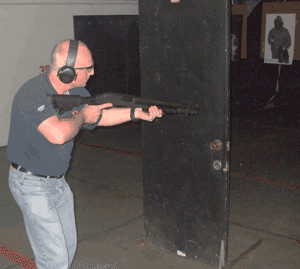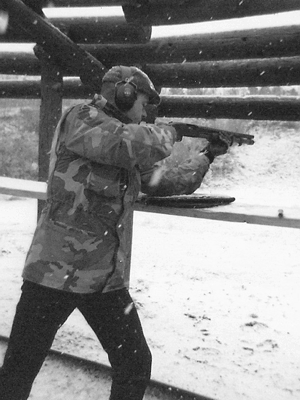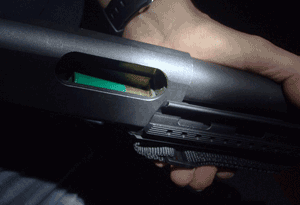As a trainer, I have conducted a good number of home-defense shotgun courses over the years. Having seen a lot of people of all descriptions and walks of life running their household scatterguns, I couldn’t help but notice a few things, and those are the basis of this article. In Part I, I shared my suggestions for accessorizing the home shotgun. In this segment are some observations about training with the shotgun as a home-defense weapon.
Keep in mind that the majority of those I work with are civilian shooters, not armed professionals. Therefore, my frame of reference for these observations is less law enforcement/tactical and more civilian homeowner responding to a threat.
The Familiar Stranger
Many of us, particularly those who subscribe to the Personal Defense Network, are already pretty savvy gun handlers. We have our brace, or battery, or collection of all kinds of guns for all kinds of reasons. We recognize the need to train and practice as frequently as possible with the gun(s) we may have to rely on in a life-or-death emergency. But for some reason, this attitude frequently fails to transition from our concealed carry pistol to the pump shotgun behind the bedroom door. In other words, I find a lot of shooters who are well-versed in their handgun skills but rarely train with a shotgun. The problem is, most of these folks have a pump-action or even a semiautomatic shotgun close to hand for home defense! We’ve all heard it:
“Yeah, I love my (insert handgun make/model/caliber here) but in the middle of the night, I’m grabbing the 12 gauge!”
When I ask, I am told by most that the shotgun’s perceived simplicity is the primary reason it is so neglected. Part of this may come from the great variety of shotguns available: muzzleloading, single barrel, double barrel, and over/under hinge action, bolt-action, lever-action, pump-action and semiautomatic are all on the market today.
Also, the shotgun in American culture has more history as a sporting tool than a weapon. In our minds, we may allow the fact that we grew up shooting pheasants with a shotgun to deceive us into believing we are proficient with our home-defense gun. That we didn’t grow up shooting intense close-range defensive drills with a pistol may explain why we subconsciously regard the two guns differently. I’ve come to think of this combination as the “familiar stranger” factor, and I simply advocate that the shotgun be incorporated into the protective mix as an equal partner with the handguns, rifles and carbines, lights, lasers, and whatever else we train with on an ongoing basis.
This “familiar stranger” factor might be the disease that keeps us from being as effective as we could be with our shotgun. Here are some common symptoms.
Lack of Conditional Awareness
I see this all the time. This is when I’m having the student complete a course of fire that involves engaging targets and moving from position to position. Under this mild duress, students will pull triggers on empty chambers (loud “click”) or will eject live rounds from the chamber when attempting to engage the target. While this can be expected at ground level from somebody who is totally new to guns, I see this happening to people who are experienced shooters — people to whom this wouldn’t happen with their carry pistol.
Another example of this effect in action is the common use of the so-called “cruiser ready” state of preparedness for the home-defense pump gun. This is a situation in which the gun has rounds in the magazine but an empty chamber. It has great appeal because the gun is thought to be “safer” but can be ready to do battle by merely racking the slide. This is especially irresistible to those who subscribe to the theory that just the sound of a pump shotgun going into battery will strike fear into the heart of any evildoer within earshot. The problem is that most gun owners will achieve “cruiser ready” via these simple steps:

Instructor Todd Hicks watches as student engages target from off-side barricade at Black Wing Shooting Center.
1. Point shotgun in a safe direction.
2. Open the action and inspect the chamber and magazine. Ensure that both the chamber and magazine are empty.
3. Close the action.
4. Insert shells into the magazine tube.
5. Place shotgun under bed or other designated area to await Bad Guy.
Most often, we find it easy to forget that step one cocked the gun and that means the pump is locked in the forward position. The result is that we grab the gun, yank rearward on the slide … and it doesn’t move. No terrifying “shak-chunk” to scare off invaders and no round in the chamber, either. Not until we go “Huh?” and remember how to fix it.
Lack of Trained Recognition and Response
This happens with pump-action shotgun users who fire their last round knowing that they need to execute a reload immediately, and yet they still close the action on the empty chamber. This despite the fact that only moments before, they were trained (or re-trained) to begin loading with the action open.
Additionally, I see shotguns misfeeding or failing to cycle due to operator error. In pump guns, it is most often the dreaded “short stroke,” in which the shooter did not move the forend far enough or vigorously enough to achieve positive ejection of a spent hull or to lock the bolt into battery. In semiautos, similar problems appear when the shooter holds the gun loosely or attempts to chamber a round by closing the bolt while the barrel is elevated. This can cause the bolt to close with insufficient force. The reason that the gun goes “muzzle up” at this moment is that the shooter is actually raising the receiver to his eyes in an attempt to visually locate the bolt release.
These symptoms and others are ultimately rooted in a lack of familiarity with the shotgun in hand. Most well-trained defensive shooters will tell you something to the effect that through repetition they’ve learned to recognize the “feel” of the semiautomatic pistol firing its last round and going to slide lock. This trained recognition negates the need for them to stop, look, and analyze the visual indicators of a slide fully retracted and an empty magazine nestled just below a wisp of smoke wafting lazily from an empty chamber. Instead, they’ll fire the shot, “feel” the lock, and initiate the reload. Running a pump or semiautomatic shotgun requires the same level of repetition if we expect to achieve the same level of recognition.
Conclusions
In short, the vast majority of speed bumps encountered on the road to home-defense shotgun happiness are there because we don’t put in the work to know the gun and run it to good effect. In my experience as a trainer, these mishaps occur so often that I have learned to embrace them as built-in teaching aids. And the shooters who experience them know the importance of regular training and practice in a way more vivid and durable than any instructor’s lecture.
If you haven’t already done so, promise yourself that you’ll dust off the family scattergun and get to the range — the sooner the better.



What about using #4 buck shot for home defense vs double ought buck? I live in a suburban neighborhood
All valid points. Just like your CCW, you need to practice with your home defense shotgun and all the iterations you make to enable the gun to be more amendable to your situations. Practice, practice, practice.
Andy, why did you leave Arizona Don's post without a response? I would hope that all the hoary old cop BS that he repeats is corrected in your classes, though!
Most of the problems mentioned here apply to pumps and perhaps a lessor degree an automatic. Using a double greener (hammer gun) eliminates nearly all these built in problems. Of course you are limited to two shots. There are other problems associated with a hammer gun but they are easily overcome with even a small amount of training and practice. For the most part unless the intruder is in hiding, and you shoot recklessly, that should be sufficient to get the job done. However, like any situation, which all law enforcement are taught in their respective academies (at least I was) a back up, to a shotgun, is always a good idea. I like a pioneer greener double 12 with a Ruger Vaquero 357 as number 1 back up. Of course there are other guns in the area which only my wife and I know. There is a big enough pattern from the greener to pretty much cover the whole hallway at any distance at all. Close up it could cut some intruder in half. Problem resolved.